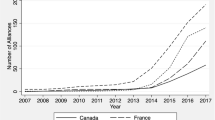Abstract
Comparing the effect on private R&D investments of allowing firms to cooperate in R&D with that of providing R&D subsidies reveals that in general the latter policy is more effective than the former in promoting R&D activity. Analyzing the implementation of both policies simultaneously reveals that subsidizing cooperative and noncooperative R&D leads to the same market outcome. The preferred R&D-stimulating policy is to subsidize optimally an agreement according to which firms only share the outcomes of their independent research.
Similar content being viewed by others
References
Arrow, K. J. (1962): “Economic Welfare and the Allocation of Resources for Invention”. InThe Rate and Direction of Inventive Activity: Economic and Social Factors, edited by R. R. Nelson. Princeton: Princeton University Press.
Bagwell, K., and Staiger, R. W. (1994): “The Sensitivity of Strategic and Corrective R&D Policy in Oligopolistic Industries”.Journal of International Economics 36: 133–150.
D'Aspremont, C., and Jacquemin, A. (1988): “Cooperative and Noncooperative R&D in Duopoly with Spillovers”.American Economic Review 78: 1133–1137.
— (1990): “Cooperative and Noncooperative R&D in Duopoly with Spillovers: Erratum”.American Economic Review 80: 641–642.
European Commission (1995): “Green Paper on Innovation”. European Commission, Brussels.
— (1996): “The First Action Plan for Innovation in Europe”. European Commission, Brussels.
Fölster, S. (1995): “Should Cooperative R&D Be Subsidized? An Empirical Analysis”. InMarket Evolution: Competition and Cooperation, edited by A. van Witteloostuijn. Dordrecht: Kluwer.
Geroski, P. A. (1993): “Antitrust Policy towards Co-operative R&D Ventures”.Oxford Review of Economic Policy 9: 58–71.
Henriques, I. (1990): “Cooperative and Noncooperative R&D in Duopoly with Spillovers: Comment”.American Economic Review 80: 638–640.
Hinloopen, J. (1997): “Research and Development, Product Differentiation and Robust Estimation”. Ph. D. thesis, European University Institute, Florence.
Jones, C. I., and Williams, J. C. (1997): “Measuring the Social Return to R&D”. Finance and Economics Discussion Series, Staff Working Paper 1997-12, Federal Reserve Board, Washington, D.C.
Kamien, M. I., Muller, E., and Zang, I. (1992): “Research Joint Ventures and R&D Cartels”.American Economic Review 82: 1293–1306.
Katz, M. L. (1986): “An Analysis of Cooperative Research and Development”.RAND Journal of Economics 17: 527–543.
Katz, M. L., and Ordover, J. A. (1990): “R&D Cooperation and Competition”.Brookings Papers on Economic Activity: Microeconomics Special Issue: 137–191.
Mansfield, E. (1985): “How Rapidly Does New Industrial Technology Leak out?”Journal of Industrial Economics 34: 907–918.
Martin, S. (1995): “R&D Joint Ventures and Tacit Product Market Collusion”.European Journal of Political Economy 11: 733–741.
— (1997): “Public Policies Towards Cooperation in Research and Development: the European Union, Japan, the United States”. InCompetition in a Global Economy, edited by W. Comanor, A. Goto, and L. Waverman. London: Routledge.
Romano, R. E. (1989): “Aspects of R&D Subsidization”.Quarterly Journal of Economics 104: 863–873.
Spence, M. (1984): “Cost Reduction, Competition, and Industry Performance”.Econometrica 52: 101–121.
Spencer, B. J., and Brander, J. A. (1983): “International R&D Rivalry and Industrial Strategy”.Review of Economic Studies 50: 707–722.
Suzumura, K. (1992): “Cooperative and Noncooperative R&D in an Oligopoly with Spillovers”.American Economic Review 82: 1307–1320.
Vonortas, N. S. (1994): “Inter-firm Cooperation with Imperfectly Appropriable Research”.International Journal of Industrial Organization 12: 413–435.
Ziss, S. (1994): “Strategic R&D with Spillovers, Collusion and Welfare”.Journal of Industrial Economics 42: 375–393.
Author information
Authors and Affiliations
Rights and permissions
About this article
Cite this article
Hinloopen, J. Subsidizing cooperative and noncooperative R&D in duopoly with spillovers. Journal of Economics Zeitschrift für Nationalökonomie 66, 151–175 (1997). https://doi.org/10.1007/BF01234404
Received:
Revised:
Issue Date:
DOI: https://doi.org/10.1007/BF01234404




